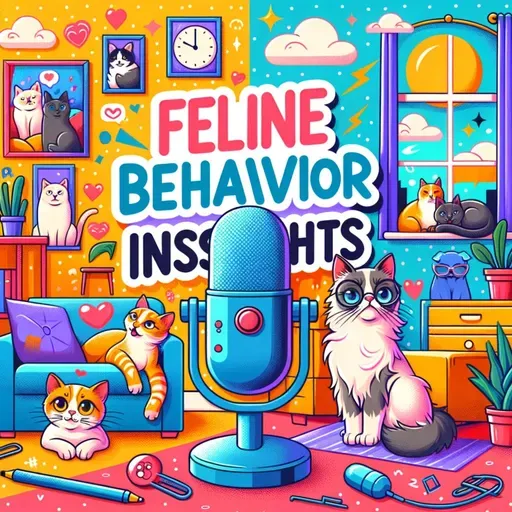
08 October 2025
"Decoding Feline Behavior: From Purrs to Pounces, Unlocking the Mysteries of Our Feline Friends"
Feline Behavior Insights
About
Feline behavior is a fascinating blend of instinct, emotion, and subtle signals that can sometimes leave even the most devoted cat lover guessing. According to Dr. Chris Roth of Pets Best, some of the most common behaviors listeners notice are purring, grooming, kneading, and the classic act of scratching. Each of these actions carries its own meaning and varies depending on the cat’s unique personality. For example, purring usually signals comfort or pleasure, but in rare cases, cats also purr when anxious, seeking to self-soothe.
Best Friends Animal Society explains that cats communicate not only through meows but also with an elaborate language of gestures. A cat circling your legs or rubbing its face against you is marking you as a friend using scent glands on its cheeks. Head butts and a tail held high with a slight tip at the end are unmistakable signs of affection. Playful cats often have big, dilated pupils and may crouch as if ready to pounce. This hunting instinct comes forward during play, which is why a cat might suddenly dart after a toy or even an unsuspecting foot.
PetMD emphasizes the importance of body language in understanding feline emotions. Relaxed cats have loose limbs and might stretch out, but a tense body and flat ears can mean stress or annoyance. If a cat’s tail is upright and gently quivering, it’s a friendly greeting. Yet, if the tail thumps or flicks rapidly when there’s nothing to stalk, the cat might be irritated. When feeling safe, some cats expose their bellies, but this isn’t always an invitation to touch—it’s more a sign of trust, so tread carefully.
Wikipedia's entry on cat behavior notes that grooming is a self-soothing activity but can become excessive if a cat is stressed. Scratching serves needs beyond sharpening claws; it also marks territory both visually and with scent. Climbing, burying, and even the mysterious “making biscuits” kneading are all holdovers from their wild ancestors. Kneading in particular is a comforting action rooted in kittenhood, when kittens knead their mothers to stimulate milk flow.
Cat communication extends into the visual as well. According to Cats Protection, a slow blink from your cat is a sign of trust and friendliness. Try blinking slowly back, and you might receive a returned gesture, affirming your bond.
Penn Today reports that scientific studies now show cats recognize their names and form strong emotional attachments to their caretakers, challenging the old myth of the aloof feline. Cats have individual personalities, shaped by genetics and early socialization, leading to a rich tapestry of behaviors from one furball to the next.
Thanks for tuning in to these insights into feline behavior. Don’t forget to subscribe. This has been a quiet please production, for more check out quiet please dot ai.
For more http://www.quietplease.ai
Get the best deals https://amzn.to/3ODvOta
This content was created in partnership and with the help of Artificial Intelligence AI
Best Friends Animal Society explains that cats communicate not only through meows but also with an elaborate language of gestures. A cat circling your legs or rubbing its face against you is marking you as a friend using scent glands on its cheeks. Head butts and a tail held high with a slight tip at the end are unmistakable signs of affection. Playful cats often have big, dilated pupils and may crouch as if ready to pounce. This hunting instinct comes forward during play, which is why a cat might suddenly dart after a toy or even an unsuspecting foot.
PetMD emphasizes the importance of body language in understanding feline emotions. Relaxed cats have loose limbs and might stretch out, but a tense body and flat ears can mean stress or annoyance. If a cat’s tail is upright and gently quivering, it’s a friendly greeting. Yet, if the tail thumps or flicks rapidly when there’s nothing to stalk, the cat might be irritated. When feeling safe, some cats expose their bellies, but this isn’t always an invitation to touch—it’s more a sign of trust, so tread carefully.
Wikipedia's entry on cat behavior notes that grooming is a self-soothing activity but can become excessive if a cat is stressed. Scratching serves needs beyond sharpening claws; it also marks territory both visually and with scent. Climbing, burying, and even the mysterious “making biscuits” kneading are all holdovers from their wild ancestors. Kneading in particular is a comforting action rooted in kittenhood, when kittens knead their mothers to stimulate milk flow.
Cat communication extends into the visual as well. According to Cats Protection, a slow blink from your cat is a sign of trust and friendliness. Try blinking slowly back, and you might receive a returned gesture, affirming your bond.
Penn Today reports that scientific studies now show cats recognize their names and form strong emotional attachments to their caretakers, challenging the old myth of the aloof feline. Cats have individual personalities, shaped by genetics and early socialization, leading to a rich tapestry of behaviors from one furball to the next.
Thanks for tuning in to these insights into feline behavior. Don’t forget to subscribe. This has been a quiet please production, for more check out quiet please dot ai.
For more http://www.quietplease.ai
Get the best deals https://amzn.to/3ODvOta
This content was created in partnership and with the help of Artificial Intelligence AI